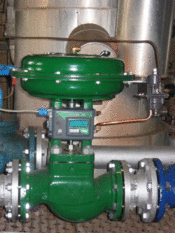User:Milton Beychok/Sandbox: Difference between revisions
imported>Milton Beychok No edit summary |
imported>Milton Beychok No edit summary |
||
| Line 1: | Line 1: | ||
'''Control valves''' are [[valve]]s used within industrial plants and elsewhere to control operating conditions such as | [[Image:Control Valve.gif|right|thumb|175px|{{#ifexist:Template:Control Valve.gif/credit|{{Control Valve.gif/credit}}<br/>|}} | ||
A typical control valve with pneumatic actuator.]] | |||
'''Control valves''' are [[valve]]s used within industrial plants and elsewhere to control operating conditions such as [[pressure]], [[temperature]], [[liquid level]] and [flow rate]] by fully or partially opening or closing in response to signals received from controllers that compare a "setpoint" to a "process variable" whose value is provided by [[sensors]] that monitor changes in such conditions.<ref>{{cite book|author=Bela G. Liptak (Editor)|title=Instrument Engineers' Handbook|edition=4th Edition|publisher=CRC Press|year=2003|id=0-8493-1083-0}}</ref> | |||
The opening or closing of control valves is done by means of [[electrical]], [[hydraulic]] or [[pneumatic]] systems. | The opening or closing of control valves is done by means of [[electrical]], [[hydraulic]] or [[pneumatic]] systems. | ||
==Applications== | |||
Control valves are used in industries such as [[Petroleum refining rocesses|petroleum refining]], [[chemical]] and [[petrochemical]] manufacturing, [[nuclear power plant]]s and [[fossil fuel power plant]]s, [[natural gas processing]] and many others. | |||
In such industries, control valves are an essential component of the systems used to control important operational parameters like pressure, temperature, liquid levels and flow rates. | |||
Pressure control valves may be used to reduce liquid or gas pressures or they may be used to maintain a back-pressure (i.e., a pressure upstream of the valve). They may also be used to maintain a pressure difference between two points in an process. | |||
Temperature control valves are used to maintain liquid or gas temperatures within process vessels or to control the heat transfer within heat exchangers and process heaters or furnaces. | |||
Level control valves are used to maintain liquid levels within a desired range in process vessels or tanks. In some cases, they may also be used to maintain levels of solid particles. | |||
Flow control valves are used to control the volumetric or mass flow rate of liquids and gases. | |||
==Types of control valve == | ==Types of control valve == | ||
The different types of control valve may be categorized as shown below: | The different types of control valve may be categorized as shown below: | ||
*Conventional | |||
*Severe | *Conventional valve | ||
*Pressure | *Severe service valve | ||
*Pressure independent control valve | |||
==Types of control valve bodies== | ==Types of control valve bodies== | ||
The different types of control valve bodies | The different types of control valve bodies include:<ref>[http://www.documentation.emersonprocess.com/groups/public/documents/book/cvh99.pdf Fisher Controls International] Control Valve Handbook</ref> | ||
*[[Angle valve]]s | *[[Angle valve]]s | ||
| Line 30: | Line 47: | ||
**Eccentric-disk control valve bodies | **Eccentric-disk control valve bodies | ||
**Eccentric-plug control valve bodies | **Eccentric-plug control valve bodies | ||
==References== | ==References== | ||
Revision as of 12:28, 19 August 2008
Control valves are valves used within industrial plants and elsewhere to control operating conditions such as pressure, temperature, liquid level and [flow rate]] by fully or partially opening or closing in response to signals received from controllers that compare a "setpoint" to a "process variable" whose value is provided by sensors that monitor changes in such conditions.[1]
The opening or closing of control valves is done by means of electrical, hydraulic or pneumatic systems.
Applications
Control valves are used in industries such as petroleum refining, chemical and petrochemical manufacturing, nuclear power plants and fossil fuel power plants, natural gas processing and many others.
In such industries, control valves are an essential component of the systems used to control important operational parameters like pressure, temperature, liquid levels and flow rates.
Pressure control valves may be used to reduce liquid or gas pressures or they may be used to maintain a back-pressure (i.e., a pressure upstream of the valve). They may also be used to maintain a pressure difference between two points in an process.
Temperature control valves are used to maintain liquid or gas temperatures within process vessels or to control the heat transfer within heat exchangers and process heaters or furnaces.
Level control valves are used to maintain liquid levels within a desired range in process vessels or tanks. In some cases, they may also be used to maintain levels of solid particles.
Flow control valves are used to control the volumetric or mass flow rate of liquids and gases.
Types of control valve
The different types of control valve may be categorized as shown below:
- Conventional valve
- Severe service valve
- Pressure independent control valve
Types of control valve bodies
The different types of control valve bodies include:[2]
- Angle valves
- Cage-style valve bodies
- Angle seat piston valves
- Globe valves
- Single-port valve bodies
- Balanced-plug cage-style valve bodies
- High capacity, cage-guided valve bodies
- Port-guided single-port valve bodies
- Double-ported valve bodies
- Three-way valve bodies
- Rotary valves
- Butterfly valve bodies
- V-Notch ball control valve bodies
- Eccentric-disk control valve bodies
- Eccentric-plug control valve bodies
References
- ↑ Bela G. Liptak (Editor) (2003). Instrument Engineers' Handbook, 4th Edition. CRC Press. 0-8493-1083-0.
- ↑ Fisher Controls International Control Valve Handbook
External links
- 'Control Valve Tutorials A number of tutorials covering the sizing, capacity and characteristics of control valves. Actuators, positioners, controllers and sensors are also discussed - Spirax Sarco
- Control Valve Handbook (4th Edition) A complete 297-page online book.
- Process Instrumentation (Lecture 8): Control valves Excellent article from a University of South Australia website.
- Control Components Inc Excellent website for reference to severe service control Valve. They are a leader in severe service control valve business.
- Valve Animations An informative series of Flash animations demonstrating conventional and pressure independent control valve operation.
